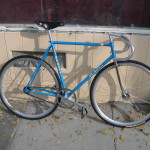The San Francisco Police Department hosted a bicycle theft prevention workshop at Google’s San Francisco offices tonight. Only 20 people came to their first workshop last year, but due to popular demand, they had a nearly full house in attendance for this evening’s session. Marc Caswell, the San Francisco Bicycle Coalition’s Program Manager, led the proceedings and asked, “How many of you have had a bicycle stolen?” Nearly everyone in the crowd raised their hand. “How many of you have gotten it back?” Sadly, only one or two folks raised their hands in response.
SFPD’s Inspector Steven Pomatto (steven.pomatto at sfgov dot org) oversees many of the stolen bike theft cases that are reported to Mission Station despite the fact he’s not a cyclist. “I don’t even really like riding bicycles,” he jokingly admitted to the group. But he’s still dedicated to rooting out cycling-related crime in the Mission, which has a rampant bike theft problem.
After his first successful case — reuniting a stolen bike recovered in the Mission with its owner in Lake Tahoe (for which he was sent a cake as a thank-you gift) — he’s developed a passion for recovering bikes through the years. Unfortunately, while there have been some happy recovery stories, the overall success rate is low: it’s usually between 5-10%.
On Average, 720 Bicycles Are Stolen From The Mission Every Year
Over 60 stolen bicycles are reported stolen in the Mission every month, and it’s more than the neighborhood police department can handle on an ongoing basis. Insp. Pomatto gave a run-down on how they prioritize the flood of cases that land on their desks:
- If there’s a known suspect.
- If there was a burglary (break-in at a private residence, etc.)
- While Insp. Pomatto didn’t have time to go into detail on when a crime registers as a misdemeanor or a felony, he stated that $1000 “was the magic number”; bicycles with that value or greater would be actively sought out. Bicycles worth less than $1000 would probably not merit a investigation. There was some debate on how to prove the value of a bicycle, e.g. if it’s used, vintage, etc. Victims should assume that the SFPD has no insider knowledge of a bicycle’s worth, so they should compile some research or paperwork that shows its market value.
- If a victim reports his/her stolen bicycle directly to Mission Station by walking in and filling out the paperwork, chances are the case will be assigned within 1-2 days to an officer. (However, photos, the bicycle’s serial number and other pertinent identifying information should be included in the report to expedite the case. Not having this information means it will likely end up nowhere.) If a theft is reported by phone or online, it will delay the process by up to 10 days.
Inspector Pomatto also described what happens to a stolen bicycle once it’s been taken from its owner: it’s usually sold elsewhere like a flea market in Oakland, Danville, Roseville, Sebastopol and American Canyon. Or it could be sold on Craigslist or eBay.
He also asked victims to please file a police report even if it’s not eventually used to recover stolen property. The reports help to create a statistical picture of where and how often thefts occur for the SFPD. They share this info with the San Francisco Bicycle Coalition and assist with their efforts to spread awareness about thefts.
Crimes of Opportunity
Insp. Pomatto recited a list of current hot spots for theft around the city: the Mission, the Japanese tea gardens in Golden Gate Park, the 16 and 24th Street BART stations, the Haight and the area around City Hall. Other tips he offered for securing bicycles included:
- Don’t lock bicycles within a big group. He warned that a thief could act as if he/she were unlocking a bicycle, but in reality could be cutting the lock and be obscured from view by the surrounding cluster of bicycles.
- Don’t lock up bicycles outside overnight.
- Don’t ever walk away from a bicycle without keeping an eye on it at all times, not even for a second. It only takes a moment for a thief to swoop in when an individual has ducked into a store or is using a public bathroom at a park. Bike thefts are a “crime of opportunity.” Don’t give them one.
Another speaker, Furlishous Wyatt of SF SAFE, talked specifically about preventing bike thefts in multiple-dwelling buildings such as condos and apartments:
- Make sure that the garage doors are completely closed before anyone leaves, as thieves can slip in during that 20-30 second gap it takes for some of them to fully lock down.
- Don’t prop open common entrances or exits unless they’re actively being used (moving items, etc.) Thieves can also slip in if doors are kept open for too long.
- Try not to store bicycles near sliding glass doors or areas that give away their presence to thieves.
The SFBC is also in the process of creating better documentation for landlords and building managers to better secure their properties on behalf of their residents.
“A Thief’s Worst Enemies Are Time, Light and Noise”
Paulie from Valencia Cyclery demonstrated one method of securing a bicycle to a parking meter or pole with a U-lock and cable. (His demo bike was a stolen Cannondale that the SFPD had recovered from a thief; is anyone missing it? They’ve been trying to find the owner for months.) He locked a small U-lock around the parking meter to the rear wheel of the bike. “If you have more room, secure the frame as well,” Paulie advised. But he recommended securing the back wheel instead of the front wheel with the lock, since it’s typically the most expensive part of the bicycle (be sure to lock within the parameters of the bicycle’s rear triangle). Then he looped a cable through the front wheel and U-lock. He also suggested using pitlocks for added security, as well as seat leashes for saddles. Insp. Pomatto remarked that Brooks saddles are one of the most commonly stolen items that are reported, but nearly impossible to track down.
Other locking tips:
- Padlocks are the most vulnerable. Don’t use them.
- While no lock can offer 100% security, employ a good locking strategy that has “layers of security”. Thieves will try to steal the bike that offers the least resistance and attracts minimal attention in the process. So if there’s a U-lock, pitlocks, a cable and saddle leash — he/she will probably go after the bicycle that is poorly secured by comparison.
- Leave as little room as possible between the U-lock and whatever it’s locked to so that the thief has less potential to use leverage to pop it open.
- Bicycles purchased from bike shops often come with a store brand sticker, e.g. “Valencia Cyclery”. These help SFPD or other law enforcement officers return stolen bicycles to their owners. After the big bike theft bust by the Ingleside PD, 5 bicycles were reunited with their owners via their bike shop stickers.
Next Steps
Mission, Park and Ingleside Police Stations are all actively working to crack down on bike theft. They’ve set up stings to catch Craigslist thieves in the past, planted a GPS-enabled “bait bike” in from of the De Young Museum in Golden Gate Park (which seemingly helped to deter some bike thieves due to the subsequent publicity) and have prosecuted thieves who have confessed to their crimes. SF SAFE is in the process of getting a city-wide bicycle registration program implemented based on Ingleside’s successful model. (Morgan St. Clair can be contacted at morgan at sfsafe dot org by anyone interested in helping out with its development or would like to implement a neighborhood watch.) In the meantime, SFPD recommends registering bicycles with the National Bike Registry. (And use the excellent free online resource Stolen Bicycle Registry if you are a victim of a theft).
Towards the end of the workshop, I asked whether the SFBC or the SFPD had ever asked Craigslist or eBay whether they’d consider selling only bicycles listed with serial numbers. Officer Matt Friedman of Mission Station replied that he had made this suggestion to these companies and had also asked them and flea markets to stop selling bicycles altogether. He said his queries fell on deaf ears. “Just one guy can’t make a difference.”
I’m hoping with the combined efforts of the SFPD, SFBC and SF SAFE — along with input and involvement from the Bay Area community – we can continue to chip away at the bike theft problem.
Additional Resources:
Stolen Bicycles Bay Area Google Group – Spread the word about stolen bicycles or share helpful info
Bicycles at Bay Area Flea Markets – Share photos of bicycles being sold at local flea markets.








